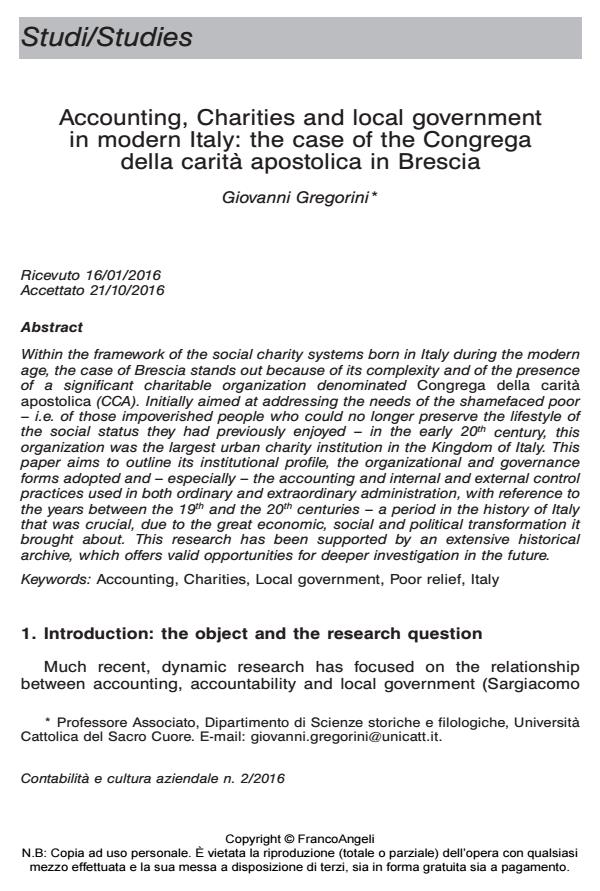Accounting, Charities and local government in modern Italy: the case of the Congrega della carità apostolica in Brescia
Titolo Rivista CONTABILITÀ E CULTURA AZIENDALE
Autori/Curatori Giovanni Gregorini
Anno di pubblicazione 2017 Fascicolo 2016/2
Lingua Inglese Numero pagine 37 P. 7-43 Dimensione file 702 KB
DOI 10.3280/CCA2016-002002
Il DOI è il codice a barre della proprietà intellettuale: per saperne di più
clicca qui
Qui sotto puoi vedere in anteprima la prima pagina di questo articolo.
Se questo articolo ti interessa, lo puoi acquistare (e scaricare in formato pdf) seguendo le facili indicazioni per acquistare il download credit. Acquista Download Credits per scaricare questo Articolo in formato PDF

FrancoAngeli è membro della Publishers International Linking Association, Inc (PILA)associazione indipendente e non profit per facilitare (attraverso i servizi tecnologici implementati da CrossRef.org) l’accesso degli studiosi ai contenuti digitali nelle pubblicazioni professionali e scientifiche
Within the framework of the social charity systems born in Italy during the modern age, the case of Brescia stands out because of its complexity and of the presence of a significant charitable organization denominated Congrega della carità apostolica (CCA). Initially aimed at addressing the needs of the shamefaced poor - i.e. of those impoverished people who could no longer preserve the lifestyle of the social status they had previously enjoyed - in the early 20th century, this organization was the largest urban charity institution in the Kingdom of Italy. This paper aims to outline its institutional profile, the organizational and governance forms adopted and - especially - the accounting and internal and external control practices used in both ordinary and extraordinary administration, with reference to the years between the 19th and the 20th centuries - a period in the history of Italy that was crucial, due to the great economic, social and political transformation it brought about. This research has been supported by an extensive historical archive, which offers valid opportunities for deeper investigation in the future.
Parole chiave:Accounting, Charities, Local government, Poor relief, Italy
- Accounting and work in the charities: The case of an Italian institution in the nineteenth century Mario Nicoliello, Farzaneh Jalali Aliabadi, in Accounting History /2022 pp.215
DOI: 10.1177/10323732221086973 - La Verna Convent's accounting and non-accounting systems: Identifying the convent's stakeholders, their mutual relations, and their engagement in value creation Ilaria Elisa Vannini, Barbara Sibilio, in CONTABILITÀ E CULTURA AZIENDALE 2/2024 pp.59
DOI: 10.3280/CCA2024-002004
Giovanni Gregorini, Accounting, Charities and local government in modern Italy: the case of the Congrega della carità apostolica in Brescia in "CONTABILITÀ E CULTURA AZIENDALE" 2/2016, pp 7-43, DOI: 10.3280/CCA2016-002002